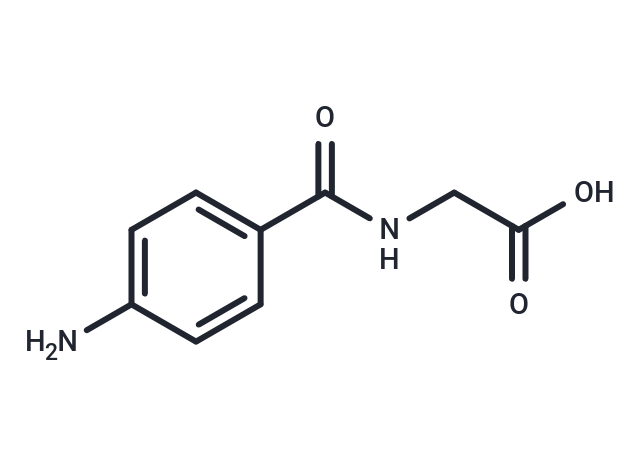Shopping Cart
Remove All Your shopping cart is currently empty
Your shopping cart is currently empty
4-Aminohippuric Acid is the glycine amide of 4-aminobenzoic acid. Its sodium salt is used as a diagnostic aid to measure effective renal plasma flow (ERPF) and excretory capacity.

| Pack Size | Price | USA Warehouse | Global Warehouse | Quantity |
|---|---|---|---|---|
| 50 mg | $35 | In Stock | In Stock | |
| 100 mg | $47 | In Stock | In Stock | |
| 200 mg | $68 | In Stock | In Stock | |
| 1 mL x 10 mM (in DMSO) | $50 | In Stock | In Stock |
| Description | 4-Aminohippuric Acid is the glycine amide of 4-aminobenzoic acid. Its sodium salt is used as a diagnostic aid to measure effective renal plasma flow (ERPF) and excretory capacity. |
| In vitro | In normal individuals, the renal extraction ratio of 4-Aminohippuric acid is approximately 0.92. After extraction, the majority of 4-Aminohippuric acid is actively secreted by the proximal tubules and completely excreted by the kidneys. The clearance of 4-Aminohippuric acid is utilized to measure renal plasma flow and to assess the secretory mechanisms or transport limits of renal tubules. The kinetics of 4-Aminohippuric acid uptake by cortical tubular cells have been measured using the stopped-flow microperfusion technique in rat kidneys. In a rat model of renal failure, intravenous injection of 3.0 mg/kg Uranyl nitrate significantly reduced the CLPAH to 0.89 mL/min/kg, compared to 29.30 mL/min/kg in normal rats. Rats with chronic kidney failure exhibited altered pharmacokinetics, showing decreased renal excretion of 4-Aminohippuric acid. Compared to Sham rats, those with chronic kidney failure demonstrated a weakened load of excretion, filtration, and secretion of 4-Aminohippuric acid, with about a 40% reduction in the expression of OAT1 in the homogenate and membrane. Hence, measuring the renal clearance of 4-Aminohippuric acid typically reflects the kidney's capacity for organic anion transport. |
| In vivo | At a concentration of 10 mmol/L, 4-Aminohippuric acid was transported across membranes of HEK293 cells expressing MRP2 with a rate of 21.9 pmol/mg protein/min. The kinetic parameters for 4-Aminohippuric acid transport included a Km value of 880 mM and a Vmax value of 2.3 nmol/mg protein/min, indicating facilitated transport through organic anion transporters expressed in epithelial cells. Additionally, 4-Aminohippuric acid uptake by HEK293 cells, mediated by overexpressed and transfected NPT1, exhibited saturable kinetics in line with Michaelis-Menten dynamics, having a Km close to 2.66 mM and a Vmax of 940 pmol/mg protein/30s. This compound is also transported by transporters other than OAT, including NPT1 and MRP2. |
| Synonyms | p-Aminohippuric acid |
| Molecular Weight | 194.19 |
| Formula | C9H10N2O3 |
| Cas No. | 61-78-9 |
| Smiles | NC1=CC=C(C=C1)C(=O)NCC(O)=O |
| Relative Density. | 1.356 g/cm3 |
| Storage | Powder: -20°C for 3 years | In solvent: -80°C for 1 year | Shipping with blue ice/Shipping at ambient temperature. | ||||||||||||||||||||
| Solubility Information | DMSO: 50 mg/mL (257.48 mM), Sonication is recommended. Ethanol: 2 mg/mL (10.3 mM), Sonication is recommended. H2O: 3 mg/mL (15.45 mM), Sonication is recommended. | ||||||||||||||||||||
| In Vivo Formulation | 10% DMSO+40% PEG300+5% Tween 80+45% Saline: 2 mg/mL (10.3 mM), Sonication is recommended. Please add the solvents sequentially, clarifying the solution as much as possible before adding the next one. Dissolve by heating and/or sonication if necessary. Working solution is recommended to be prepared and used immediately. The formulation provided above is for reference purposes only. In vivo formulations may vary and should be modified based on specific experimental conditions. | ||||||||||||||||||||
Solution Preparation Table | |||||||||||||||||||||
Ethanol/H2O/DMSO
| |||||||||||||||||||||
| Size | Quantity | Unit Price | Amount | Operation |
|---|

Copyright © 2015-2025 TargetMol Chemicals Inc. All Rights Reserved.